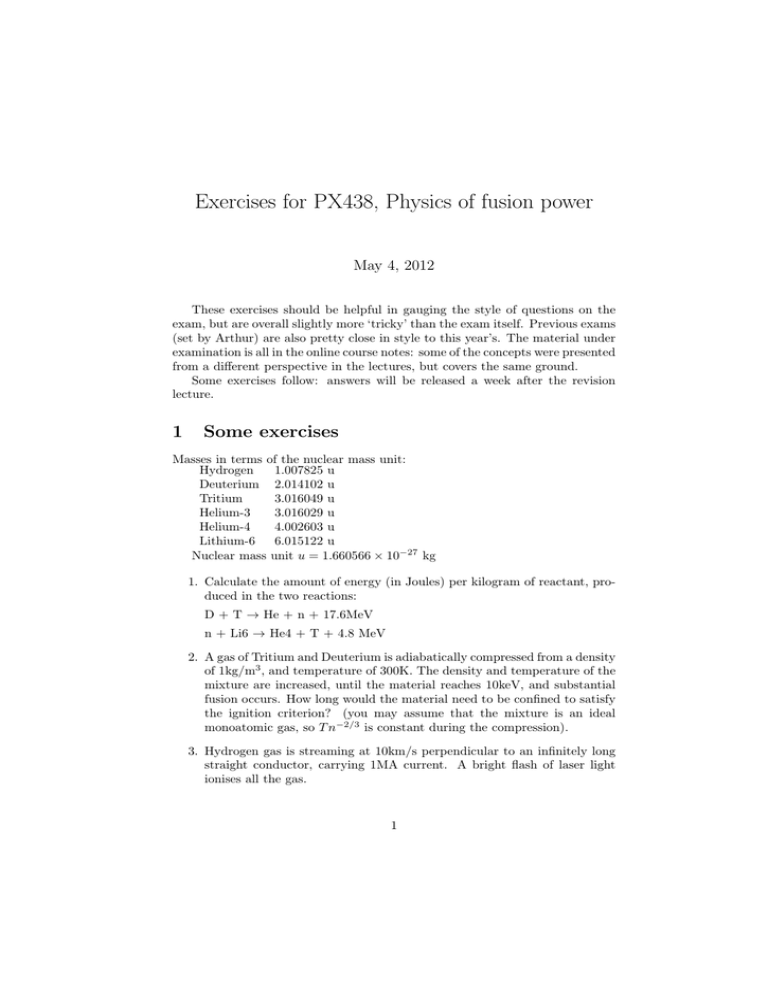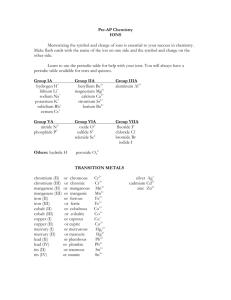Exercises for PX438, Physics of fusion power May 4, 2012
advertisement

Exercises for PX438, Physics of fusion power May 4, 2012 These exercises should be helpful in gauging the style of questions on the exam, but are overall slightly more ‘tricky’ than the exam itself. Previous exams (set by Arthur) are also pretty close in style to this year’s. The material under examination is all in the online course notes: some of the concepts were presented from a different perspective in the lectures, but covers the same ground. Some exercises follow: answers will be released a week after the revision lecture. 1 Some exercises Masses in terms of the nuclear mass unit: Hydrogen 1.007825 u Deuterium 2.014102 u Tritium 3.016049 u Helium-3 3.016029 u Helium-4 4.002603 u Lithium-6 6.015122 u Nuclear mass unit u = 1.660566 × 10−27 kg 1. Calculate the amount of energy (in Joules) per kilogram of reactant, produced in the two reactions: D + T → He + n + 17.6MeV n + Li6 → He4 + T + 4.8 MeV 2. A gas of Tritium and Deuterium is adiabatically compressed from a density of 1kg/m3 , and temperature of 300K. The density and temperature of the mixture are increased, until the material reaches 10keV, and substantial fusion occurs. How long would the material need to be confined to satisfy the ignition criterion? (you may assume that the mixture is an ideal monoatomic gas, so T n−2/3 is constant during the compression). 3. Hydrogen gas is streaming at 10km/s perpendicular to an infinitely long straight conductor, carrying 1MA current. A bright flash of laser light ionises all the gas. 1 i) Describe the form of the motion parallel and perpendicular to field line, of a particle starting at a particular radius r, travelling initially at an angle θ to the field line. Find the the trajectories of the gyrocentres of the hydrogen ions. For the purposes of this problem, assume that the ions do not interact with each other or the electrons. ii) How accurate is the approximation that the orbits can be described by a circular gyromotion? (n.b. the symmetry of this problem is sufficient to allow an analytical single particles motion without the assumption of small gyroradius) 4. A single circular coil carrying an electric current can be used to confine plasma, as all the field lines except the one running along the axis are closed. i) Describe the trajectories of plasma ions in this device. Find the condition which determines whether a particular ion’s trajectory will pass through the coil. ii) At the centre of symmetry of the coil, a source of hydrogen plasma emits 1mg/s of hydrogen ions. The power of the plasma source is 1kW, deposited entirely as ion thermal energy (the initial distribution of these ions is Maxwellian). Find the parallel and perpendicular velocities of the ions, assuming they are non-interacting, in terms of the magnetic field strength and their initial velocities. A solid target plate is placed perpendicular to the axis of the coil, a long distance from the centre of the coil, and ions stream onto this plate, transferring their momentum to the plate. Calculate the force applied to this target. 2








